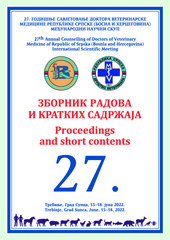Приказ основних података о документу
Trichinella infection in Serbia
Infekcija trihinelom u Srbiji
| dc.creator | Vasilev, Saša | |
| dc.creator | Mirilović, Milorad | |
| dc.creator | Ignjatović, Marija | |
| dc.creator | Milakara, Emina | |
| dc.creator | Mitić, Ivana | |
| dc.creator | Plavšić, Budimir | |
| dc.creator | Plavša, Dragana | |
| dc.creator | Bošković, Tamara | |
| dc.creator | Vasilev, Dragan | |
| dc.creator | Karabasil, Nedjeljko | |
| dc.creator | Sabljić, Ljiljana | |
| dc.creator | Ilić, Nataša | |
| dc.creator | Živojinović, Milena | |
| dc.creator | Sofronić Milosavljević, Ljiljana | |
| dc.date.accessioned | 2022-09-29T07:18:40Z | |
| dc.date.available | 2022-09-29T07:18:40Z | |
| dc.date.issued | 2022 | |
| dc.identifier.isbn | 978-99955-770-9-4 | |
| dc.identifier.uri | https://vet-erinar.vet.bg.ac.rs/handle/123456789/2486 | |
| dc.description.abstract | U Srbiji trihineloza je jedna od najznačajnijih zoonoza koje se prenose hranom. Prvi izveštaj o nalazu kod svinja je iz 1918. godine, a prvi slučaj kod ljudi 1923. godine u Zemunu. Detekcija prisustva trihinele je prvobitno vršena trihineloskopijom. Od 1984. uvedena je veštačka digestija. Savremeni sistemi proizvodnje svinjskog mesa, mere kontrole, metoda veštačke digestije eliminisali su meso svinja sa velikih farmi kao izvor trihineloze. Prvi put u Srbiji Nacionalna referentna laboratorija za trihinelozu (NRLT) organizovala je 2017. godine kontrolu kvaliteta rada za detekciju larvi trihinele u mesu metodom magnetne mešalice (MSM). Svi učesnici (veterinarski instituti) uspešno su prošli testiranje. Članovi tima NRLT napravili su (2019. godine) novi cELISA test za otkrivanje infekcije trihinelom kod životinja i ljudi i Svetska komisija za trihinelozu ga je prepoznala kao koristan za međunarodnu upotrebu. Epidemiološki podaci iz poslednjih decenija ukazuju da je broj obolelih ljudi kao i broj zaraženih životinja značajno smanjen. Svinjsko meso je godinama najčešći izvor infekcije ljudi u Srbiji. Slučajevi se javljaju u porodičnim epidemijama i rizik je povezan sa konzumacijom svinjskog mesa u kome se nalaze larve Trichinella, a uzgajaju se bez primene higijenskih pravila i životinje nisu veterinarski testirane (epidemija u Obrenovcu i Parizu, Francuska). U većini slučajeva T. spiralis je bila etiološki agens infekcije, ali smo u 2016. godini imali veliku epidemiju izazvanu konzumacijom mesa divljih svinja koje je sadržalo larve T britovi (Čajetina, 123 osobe). Važno je: 1. Lovce i potrošače mesa svinja i mesa divljači u Srbiji edukovati o riziku u vezi sa konzumiranjem neproverenog mesa. 2. Kontrola sistema kvaliteta kod veterinarskih subjekata koji rade testiranje na prisustvo larvi trihinele u uzorcima mesa, kao i redovno učešće u PT. | sr |
| dc.description.abstract | In Serbia Trichinellosis is one of the most important foodborne zoonotic diseases. The first report of swine infection was in 1918 and first human case was in 1923. From 1984 artificial digestion was adopted for use in preventing human trichinellosis. Modern pork production systems, implemented control measures, artificial digestion method have eliminated farm pork as a source for trichinellosis. For the first time in Serbia National Reference Laboratory for trichinellosis (NRLT) organized in 2017 proficiency test (PT) for the detection of Trichinella larvae in meat by Magnetic Stirrer Method (MSM). All participants (veterinary institutes) successfully passed the testing. Members of NRLT team made (in 2019) new cELISA test for detection of Trichinella infection in animals and humans and the ICT recognized the test as useful for international use. Epidemiological data from the last decades indicate that the number of human cases as well as the number of infected animals has decreased significantly. Over the years, pork was the most frequent source of human trichinellosis. Cases generally occurred in family outbreaks and risk is linked to untested backyard pork consumption. Meat and meat products offered to relatives and friends may be source of infection with Trichinella when backyard pigs are raised without any compliance with hygienic rules and animals are not veterinary tested. In most numbers of outbreaks T. spiralis were the etiological agent of infection but in 2016 we had a large outbreak provoked by consumption of wild boar meat containing T britovi larvae. It is important that: 1. Hunters and consumers of backyard pigs and wild game meat should be educated about the risk associated with consumption of untested meat. 2. Control of Trichinella QA system in veterinary subjects (testing for Trichinella presence in meat samples) and regularly participation in PTs are needed to achieve safe food for consumers. | sr |
| dc.language.iso | sr | sr |
| dc.language.iso | en | sr |
| dc.publisher | Veterinarska komora Republike Srpske | sr |
| dc.relation | info:eu-repo/grantAgreement/MESTD/inst-2020/200019/RS// | |
| dc.rights | openAccess | sr |
| dc.source | 27. godišnje savjetovanje doktora veterinarske medicine Republike Srpske (Bosna i Hercegovina) | sr |
| dc.subject | Trichinella infection | sr |
| dc.subject | Trichinellosis | sr |
| dc.subject | Serbia | sr |
| dc.subject | infekcija trihinelom | sr |
| dc.subject | trihineloza | sr |
| dc.subject | Srbija | sr |
| dc.title | Trichinella infection in Serbia | sr |
| dc.title | Infekcija trihinelom u Srbiji | sr |
| dc.type | conferenceObject | sr |
| dc.rights.license | ARR | sr |
| dc.identifier.fulltext | http://veterinar.vet.bg.ac.rs/bitstream/id/7127/bitstream_7127.pdf | |
| dc.identifier.rcub | https://hdl.handle.net/21.15107/rcub_veterinar_2486 | |
| dc.type.version | publishedVersion | sr |
| dc.identifier.cobiss | 136311041 |

